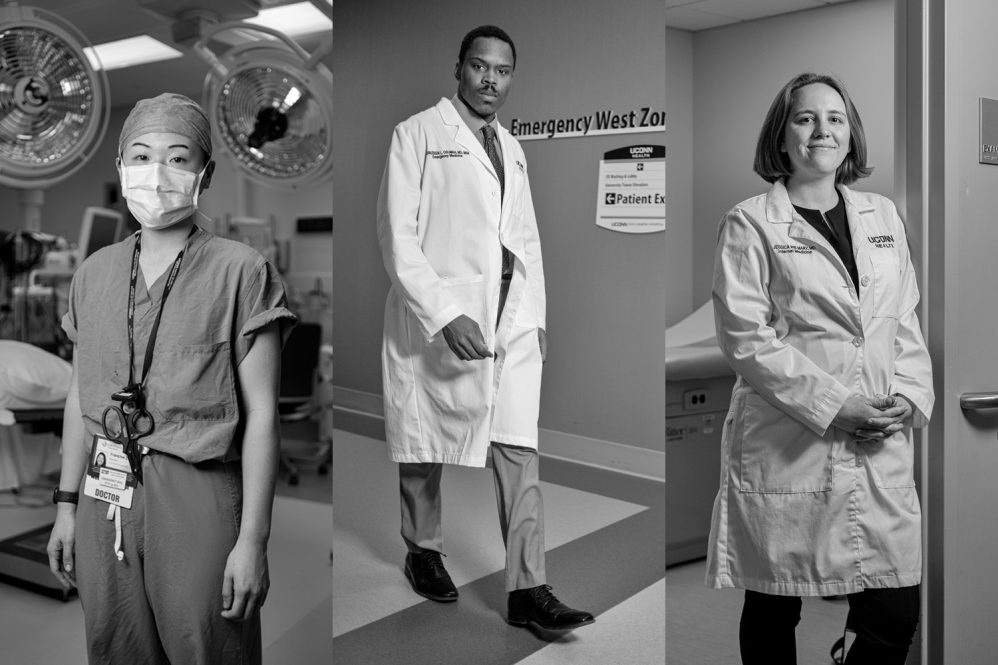It’s both an ending and a beginning: Match Day — when soon-to-be doctors find out where they will go for their residencies.
Moments before noon on March 18, 2022, three fourth-year medical students count down the seconds along with their classmates. They’ve known for four days that they’ve been paired with a program, but they are about to learn which. Is it their top choice? Where will they be living in just four months?
Dr. Francine Zeng ’18 (CLAS), ’22 MD watches the clock from her home in South Windsor, Connecticut, her sights set on an orthopedic surgery specialty at UConn Health. A dentist’s daughter, Zeng always knew she wanted to enter a medical field — though, no offense to her father, she just doesn’t love mouths. She discovered orthopedic surgery early in the program, when she had her first clinical and operative experience with an orthopedic surgeon who became a mentor. It was there that she fell in love with the OR.
“I love how operating works,” Zeng says. “It is a very intimate, very intense procedure. But what I love about it is that you can actually just go in there and fix the problem that you’ve identified, and hopefully that’s ultimately going to be what makes the patient feel better and helps them reach their goal of achieving their function back.”
What is Match Day? During the fourth year of med school, students choose a specialty, apply to programs, interview, and rank their top choices. The programs rank their favorites, too, and an algorithm decides who goes where.
Fifty-some miles south, at home in West Haven, Dr. Nurudeen “Lucky” Osumah ’21 MBA, ’22 MD waits with his family by his side, hoping that he will be able to pursue emergency medicine at UConn Health. Osumah’s path to the white coat has been untraditional — he took a year off from medical school to earn an MBA from UConn after attending a medical conference during his third year.
“They were talking about quality assurance metrics or something, and all I remember is how the back-and-forth between the doctors and the admins was going,” he recalls. “They both wanted the best for the patient, but both had different ways to go about it, and it created conflict.”
Osumah decided he wanted to learn how to bridge that gap between health care administrators and health care providers so that, somewhere down the line, he can sit at that crossroads and play the role of mediator, understanding where both sides are coming from and reaching a shared goal: better health care for the patients they all serve.
Dr. Jessica Mary ’18 (CLAS), ’22 MD, wants to stay at UConn, too, to practice internal medicine. She’s anxiously waiting to learn whether she’ll be signing the lease papers for a new apartment in New Britain later that afternoon — she’s been pushing off the landlord until she knows for sure where she’s matched.
The daughter of chemists, Mary grew up steeped in science but always knew she was more drawn to the human side than the lab bench.
“I know that I’m a much more cerebral person, and I wanted to do something that was more thought-based than procedure-based,” she says. “What I really love about internal medicine is that you do get to think about the body as a whole. You get to think about how everything interplays.”
As an undergraduate Mary enrolled in UConn’s Special Program in Medicine, a four-year pre-med track, but it was a trip to the Dominican Republic with a pre-medical society — shadowing physicians in hospitals and contributing to medical care in a rural community on the island country — that cemented her desire to become a doctor.
“I had looked at different parts of health care, thought maybe nursing for a while,” she says, “but after that, I was totally sold on it. Yes, this is definitely what I want to do, and I knew I wanted to do it at UConn.”
At 12 p.m., each of the three students checks for the email that will reveal their fate.



